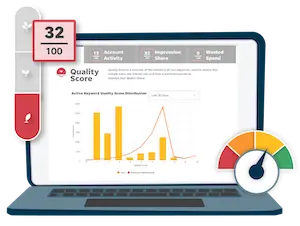Conversion tracking is a feature in Google Ads that keeps tabs of what meaningful actions are completed by visitors on your website or landing page. This is to help you better understand the effectiveness, as well as the return on investment, for your ad spend and marketing efforts.
But as great as it sounds, it gets complicated. You start hitting snags. Conversions fall off. Things start breaking. Next thing you know, you’re in an account with skewed conversion data and no idea if the money put towards your ads is actually making a difference in your business’s success.
In this guide, I’m going to explain why every business needs conversion tracking (no ifs, ands, or buts!), go over conversion tracking setup and metrics, and then run through the eight most common hang-ups I see with Google Ads conversion tracking (and how to fix them, of course!). They include:
- Not knowing what to track
- No conversion data or low conversion rates
- Conversion data seems off
- Need to remove/add a conversion
- Conversion action unclear
- “No recent conversions” or “tag inactive” notification
- New landing page, old conversion tracking setup
- Conversions just (poof!) fell off
By the end, you’ll know how to set up and troubleshoot your Google Ads conversion tracking so that the data you look at in your account is accurate every time, guaranteed.
So let’s begin.
Fact: EVERY business needs conversion tracking
As a WordStream consultant, I’ve come across plenty of folks who prefer to not have conversion tracking set up. Usually, this is because they manually track conversions on their own or because they sometimes are unsure of what tracking could look like for them. After all, not every business is a cookie-cutter purchase or call-based model. However, I always advise against this because there’s a fit for tracking in every account.
Some of the more typical conversion actions include calls, form fills, and purchases, but there are many more that could be a better fit for your business, such as live chat messages, content downloads, and bookings (more on that later).
At the least, conversion tracking is a way to quantify the value of your advertising. At the most, it’s an imperative grounding metric to make sense of all other data points within your account. Since all PPC decisions are usually made based on historical data (because no one likes just guessing), then you really need conversion tracking set up right if you want to continuously optimize your account and get the best bang for your buck.
How to set up Google Ads conversion tracking (correctly)
While there are many types of conversion actions to choose from, the setup process is essentially the same throughout.
In short, Google generates a bit of HTML code that you paste into the webpage on your site that customers visit immediately after completing the conversion (such as an order confirmation or thank you page.
To get started, click on the Tools section in Google Ads, and select Conversions from under Measurement in the drop-down menu, which brings up the Conversion actions section, then click the +Conversion button to create your first conversion.
You’ll be prompted to fill out a form that will help Google Ads generate the appropriate HTML code for you to just paste right into your webpage.
Give the conversion a name, such as “Contact Form Submissions” if you want to track how many times visitors fill out your site’s Contact Us form.
Then, you’ll select the source of the conversion and Google will prompt you through the implementation process from there. Your source choices are:
- Webpage: If you want customers to complete an action on your webpage, such as an online purchase, contact form submission, or page visit.
- Call on-site: If you want customers to call the phone number on your site from a mobile device.
- App download: If you want customers to download your app.
- Import: If you want to import an offline custom conversion from a third-party provider.
Metrics available through Google Ads conversion tracking
So, now you have your tracking set up (and have hopefully avoided these conversion tracking mistakes) and you’re starting to see some conversion data come through (yay!). Let’s quickly review the conversion metric columns Google provides us so that we can better understand our conversion activity:
- Conv. (1-per-click): Counts each time you receive one or more conversions from a single ad-click. You can use this number to approximate the number of new customers you’re getting.
- Cost / conv. (1-per-click): Displays your cost (how much you spent on clicks) divided by your total conversions. This helps you measure your return on investment (ROI). Ideally, you should be spending less on clicks than you’re earning on conversions. This metric is also commonly known as Cost Per Acquisition or Cost Per Action (CPA).
- Conv. rate (1-per-click): Shows the percentage of clicks that resulted in conversions. The higher the percentage, the more effectively the ads or keywords are performing.
- View-through conv.: Measures the number of times a customer viewed, but did not click on, your ad and later went through with a conversion.
8 reasons your Google Ads conversion tracking isn’t working
Alright so now that we’ve covered the basics for conversion tracking, let’s go over the eight most common hang-ups I see businesses run into with their Google Ads accounts.
1. Not knowing what to track
What’s wrong
One common misconception with conversion tracking is that your actions have to be run-of-the-mill, old-fashioned transactions, like purchases. But we know that for most businesses, it’s not always that easy.
How to fix it
If you’re unsure of what actions you should track as meaningful conversions, you’ll first want to take a step back and walk through your customer journey. If you have a longer sales cycle or generally a more complex product or service, then your ideal customer probably won’t convert right away after visiting your site just one time from an ad.
Or, maybe that conversion happens offline via a sales rep call. But that doesn’t mean your visitors can’t complete meaningful actions once they land on your web page.
You may have to get creative and provide things for your potential clients to do. Now, this might not always directly equate to something that makes you money right away. But, these actions help to push your leads further down your funnel so they can eventually convert into customers.
Actions like these include downloading a whitepaper, providing an email in a pop-up, viewing a video, engaging in live chat, viewing a page, and so much more. So get creative with what you want to track because the more ways you have to quantify your customer’s actions each step of the way, the better!
2. No conversion data or low conversion rates
What’s wrong
So, you thought you had conversion tracking good to go, but after some time you’re digging through your account for little to no conversions to be found. Why aren’t your Google Ads converting?
How to fix it
Remain calm and follow these three steps:
Rule out performance first!
We cannot stress this one enough. It’s easy to scapegoat your tracking when you see that conversions are low, but we’ll have to look retrospectively at the account to ensure there’s really nothing going on performance-wise.
One indicator is if conversion data just seems slightly low (and not just zeros across the board) then we know right off the bat there’s some sort of action still being tracked, so it might not totally be the tracking’s fault.
You may want to view your change history to double-check any tweaks you made to the account that could have caused a performance dip. Ask yourself these types of questions:
- Were budgets or bids lowered?
- Do my keywords have a lower search volume, meaning maybe they’re just less popular?
- Have I historically had lower activity during this time of year?
Read through the “Conversions” section of Google Ads
We touched on how to create conversions via the Conversions section of Google Ads, but being able to read through the data it puts out is just as important. Navigate to that same section to cross-check what actions are currently being counted as conversions.
Then find in the next column over what type of conversion each action is.
Then check to see if there has been any recent activity on that action’s tag under tracking status. If not, then you know conversions may just be slow.
On the right-hand side, you can see how many conversions have come in as well. As for repeat rate, that’s just the average number of conversions you receive based on interactions that lead to at least one conversion.
These are all important columns to be familiar with to see if conversions are just slow, not working, or being recorded incorrectly. If you’re unsure of a column, simply hover over the title at the top of the column and Google will remind you of the definition as well.
Try out the Google Tag Assistant browser plugin
Google has also come out with a handy tool to check up on the tags on our landing page. Google Tag Assistant is a plugin you can download and install on your browser that will run tests on whatever page your browser is on.
For example, if you’re still unsure after the two steps above whether your tags are firing correctly or potentially duplicated, you can run the tag assistant which will report back live which tags it picks up. It color-codes the tags to tell you if there are any issues with them, and provides the tag code so you can cross-check this with the code once you click into the selected conversion action of the conversion section.
3. Conversion data seems off
What’s wrong
You’ve always brought in a ton of sales, but your conversion metrics have been crazy slow, or vice versa.
How to fix it
On top of remembering to rule out performance first and leveraging the GTM plugin to check for double tags or tags on the wrong page, you’ll also want to check two specific portions of that “Conversions” section again.
Check the “Recent Activity” and “Include in Conversions” columns
For example, recent activity can show whether you haven’t brought in a conversion in a while (“tag inactive” or “no recent conversions”). Or, your “Include in Conversions” column will show whether that action’s conversion data will be reported in your conversion columns on your campaigns. If that column says No when it’s supposed to say Yes, then you’ll want to click into it to edit it and say yes—as long as it’s not Google Hosted (Google Hosted conversions will never show in the conversions columns).
Cross-check with your backup tracking
Finally, but most importantly, you’ll want to always have a backup way of tracking your conversions on your end to cross-check. This could be via Google Analytics, a CRM, a marketing partner interface, or manually tracking what comes in on your end.
If you have your own backup method of conversion tracking that you’re in charge of then not only will your data not be lost if tracking issues pop up, but you’ll be able to cross-check to see if your Google Ads data really is off or not.
4. Need to remove/add a conversion
What’s wrong
You realize you forgot to add in a conversion action you wanted to track. Or, on the opposite end, your conversion data is skewed higher because it’s accounting for an action you no longer want to track.
How to fix it
To add: Easy peasy! Refer back to our setup section and follow the prompts to add that action in, so it can be included in data moving forward.
To remove: Navigate to the Conversions section of Google Ads under Tools, then Measurement, and click on the name of the conversion action you’d like to remove. Once you’re in that conversion’s separate informational section, you can hit Edit on that information box and uncheck the “Include in Conversions” option. You can also remove the tracking code from your site’s backend as well.
5. Conversion action unclear
What’s wrong
You’re seeing conversion data come through in your Google Ads columns, but you’re not sure what that conversion actually is or what that might mean for your customer journey.
How to fix it
This is a bit of a tricky one, and I hate to be the bearer of bad news here, but there will be some things in Google Ads that the platform just does not have the capability to report on.
For example, if you’re trying to attribute one specific keyword or ad to one specific conversion, then that is virtually impossible. And while you can sort of get an idea by digging through your converting keywords or ads and finessing the date range to match when that specific conversion came in, you’ll never know for sure which action that is if you have multiple set up.
However, what you can do is cross-check your actions back in that Conversions section. So, if you navigate back to your conversions section it will list out how many of those specified actions were completed within your selected time frame.
If you want to dial that in even further if, say, you had a different thank you page based on locations, click on those actions and go to the Webpages section within them to see a breakdown of the total conversions split out by page.
6. “No recent conversions” or “tag inactive” in the Conversions section
What’s wrong
You’re in your Conversions section of Google Ads and you see big red, scary text that says one of these two phrases “tag inactive” or “no recent conversions.” But maybe you’ve converted fairly recently, so how could this be?
How to fix it
This one is a breeze since it’s really a no-action-needed issue! While those texts under your Recent Activity seem like a glaring red flag, once we hover over them Google reminds us that these are fairly innocuous.
They both mean you haven’t had conversions within the last 7-day (no recent conversions) or 30-day (tag inactive) period. It does not mean that you are not tracking properly, but that conversions have just been slow for that particular action. So, the only plan of action is potentially evaluating your account performance to see if there are any optimizations you can do to boost conversion frequency.
Evaluate your Google Ads account performance with our Free Google Ads Performance Grader.
7. New landing page, old tracking set up
What’s wrong
You’re excited to have finally put live that new landing page you’ve been working at, but how do you handle tracking since it’s been previously set up on your old page?
How to fix it
Okay, to be honest, we added this one to also partially serve as a reminder that your new landing page usually requires a few housekeeping updates to ensure the continuity of your conversion tracking goes smooth as silk.
If it’s a totally new page then it most likely will not have your old tags on it (unless it redirects to an old thank you page or specific situations similar to that). So, you’ll treat this the same as the set-up steps listed above to just implement the tracking fresh again as if it were new.
The last step is to always keep in mind that you’ll need to swap out all final landing page URLs on your ads (including paused ones so Google doesn’t flag you for a “destination mismatch” between new and old landing pages within the same ad group).
8. Conversions just (poof!) fell off
What’s wrong
You had conversions flowing in at a steady pace and then they dropped drastically to almost nothing or even zero.
How to fix it
Okay, so if there’s suddenly zeros across the board for your conversion data, then your tracking has a 99% chance of being the problem.
Remain calm!
The first place you need to go is back to that change history as mentioned in hang-up number two so that performance can be ruled out completely. Then, follow the audit steps we discussed leveraging the Conversions section of Google Ads as well as the Google Tag Manager to identify any weaknesses in your tracking. It may take reinstalling a tracking tag or changing what’s being tracked to get you back on track, and that’s okay!
Now you can reap the benefits of Google Ads conversion tracking
Overall, it can be easy to automatically freak out about anything related to conversion tracking because it can feel complex with lots of moving parts and coding elements to it. But you don’t need to be a web wiz to at least troubleshoot what tracking means for you in terms of your PPC account performance. So, if you go into any issues head-on then methodically untangle them, you’ll find that you can usually fix the problem or come up with a solution for a stress-free continuation of your ad campaign.








